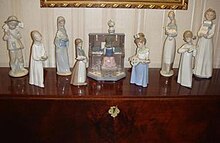| Revision as of 00:17, 30 November 2007 editYoussefa (talk | contribs)161 edits Added infobox and company logo.← Previous edit | Revision as of 15:03, 18 December 2007 edit undoDismas (talk | contribs)Autopatrolled, Extended confirmed users, File movers, IP block exemptions, Pending changes reviewers79,891 editsm →In Popular Culture: italics for TV series/film titles, double quotes for episodesNext edit → | ||
| Line 48: | Line 48: | ||
| ==In Popular Culture== | ==In Popular Culture== | ||
| In an episode of the ] |
In an episode of the ] '']'' (7x12, "Christmas Break"), ]'s mother Marilyn (portrayed by ]) had a collection of Lladrós, her favorite being 'Ouisan, the bashful ].' She was described as being priceless; the humour of the episode revolved around the fact that ] had broken her and was fearful of Marilyn finding out, as she was very precious to her (she declared her desire to discover who had done it and to "pour ] on something they love"). | ||
| In |
In '']'', ] boasts about her Lladró figurine in "]" (4x6). In the episode "]" (6x16), Carmela breaks the figurine by throwing it at ]. | ||
| ==External links== | ==External links== | ||
Revision as of 15:03, 18 December 2007
 | |
| Company type | S.A. |
|---|---|
| Founded | 1953 |
| Headquarters | |
| Products | Ceramic Art Porcelain Figurines |
| Website | www.lladro.com |
Lladró (IPA ) is a Spanish company based in Tavernes Blanques, Valencia, that produces high quality porcelain figurines.
History

The company was founded in 1953 by three brothers, Juan, José and Vicente Lladró, in the village of Almácera near Valencia. Starting with items such as vases and jugs, it wasn't until 1956 that they started producing the sculptures for which they are now most famous. Enthusiasm for the items produced by the Lladró brothers saw their small workshop expand several times until eventually they moved to Tavernes Blanques in 1958.
- 1962, the brothers open the Professional Training School at their site in Tavernes Blanques to share their knowledge and experience. It still operates today keeping alive the vision and philosophy of the brothers by imparting it to a new generation.
- 1969, on October 13, the City of Porcelain is opened by the Spanish Minister for Industry. It took 2 years to build and was designed to provide the best environment that encourages the artistic development of works produced. Currently over 2000 people work here.
- 1970, Lladró begins to use a new material, gres, for its sculptures. It has earthy colours and is used frequently in natural themes.
- 1973, Lladró buys 50% of the North American company Weil Ceramics & Glass.
- 1974, the first blue emblem, consisting of a bellflower and ancient chemical symbol, appears on the base to show the origin of the sculpture. The Elite Collection is also launched.
- 1984, Rosa, Mari Carmen and Juan Vicente Lladró joined the company. One child of each of the founding members. They underwent a long apprenticeship before they were permitted responsibility in the company.
- 1985, the Collector's Society is formed. The first annual sculpture, called "Little Pals", can fetch several thousand dollars at auction due to the small number of members able to purchase it in the early years.
- 1986, Lladró forms an alliance with the Mitsui Group creating a subsidiary called Bussan Lladró based in Tokyo
- 1988, on September 18 in New York the Lladró Museum and Gallery is opened on 57th Street in Manhattan.
- 1993, Lladró receives the Principe Felipe award for internationalisation.
- 2001, Lladró Privilege, a new customer loyalty programme, takes over from the Lladró Collectors Society.
- 2004, Lladró Privilege Gold, a new level of loyalty programme within the Privilege program.
Technique
The manufacturing ingredients are kept under tight guard. The process is detailed in a number of Lladró publications and is fully on view for tour groups and individuals at the City of Porcelain. Lladró figurines are made out of an original blend of hard-paste porcelain, which gives the products their unique porcelain characteristics. The glaze ingredients also add to the look of the figures and is an industry secret.
Marketing
Lladró figurines are given an additional title in English as well as the Spanish original, however these names are frequently not translations (figurative or literal) but new names that are more likely to appeal to an English speaking audience. A further area for confusion is that the names of the pieces can change throughout their run so the same figurine can often end up with several titles.
In Popular Culture
In an episode of the sitcom Will and Grace (7x12, "Christmas Break"), Will's mother Marilyn (portrayed by Blythe Danner) had a collection of Lladrós, her favorite being 'Ouisan, the bashful geisha.' She was described as being priceless; the humour of the episode revolved around the fact that Grace had broken her and was fearful of Marilyn finding out, as she was very precious to her (she declared her desire to discover who had done it and to "pour bleach on something they love").
In The Sopranos, Carmela Soprano boasts about her Lladró figurine in "Everybody Hurts" (4x6). In the episode "Chasing It" (6x16), Carmela breaks the figurine by throwing it at Tony Soprano.